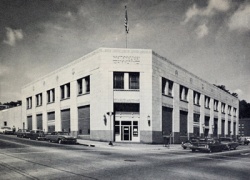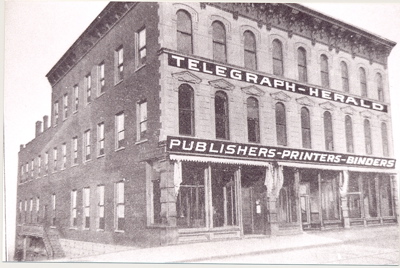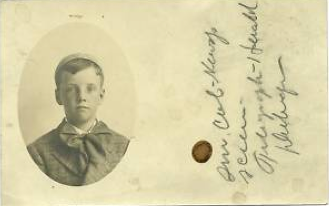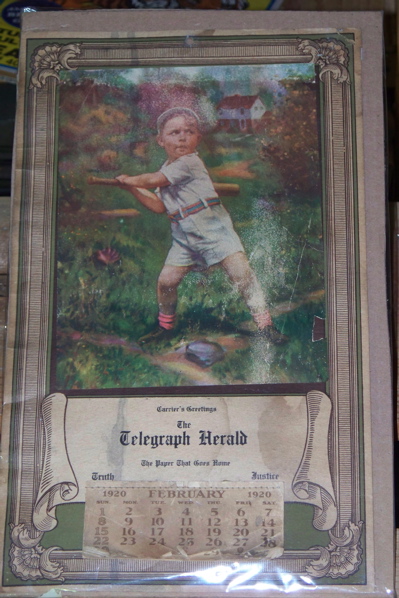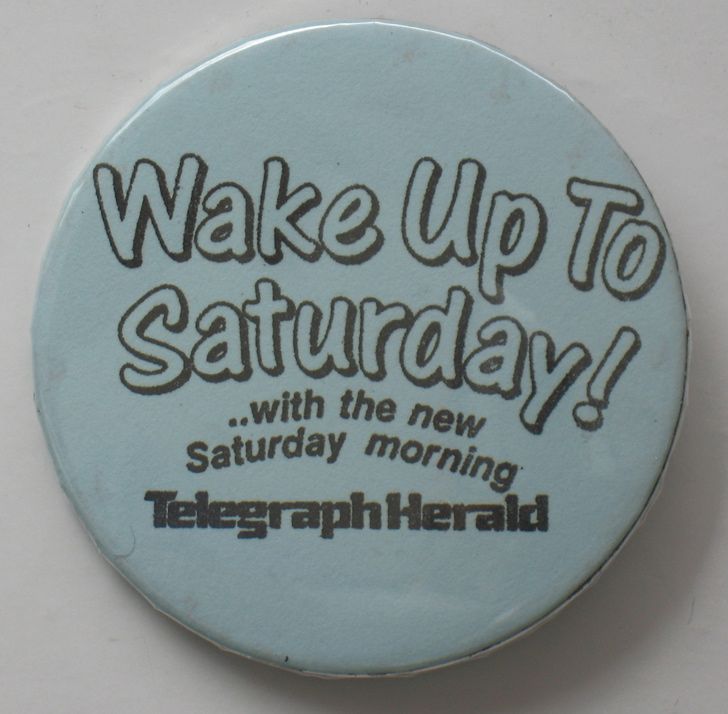Encyclopedia Dubuque
"Encyclopedia Dubuque is the online authority for all things Dubuque, written by the people who know the city best.”
Marshall Cohen—researcher and producer, CNN
Affiliated with the Local History Network of the State Historical Society of Iowa, and the Iowa Museum Association.
TELEGRAPH HERALD: Difference between revisions
No edit summary |
No edit summary |
||
| Line 1: | Line 1: | ||
This entry is being edited. | |||
[[Image:imp917.jpg|right|thumb|250px|Telegraph Herald, 801 Central. Photo courtesy: Bob Reding]] | [[Image:imp917.jpg|right|thumb|250px|Telegraph Herald, 801 Central. Photo courtesy: Bob Reding]] | ||
TELEGRAPH HERALD. The successor to Dubuque's many [[NEWSPAPERS]]. Dubuque's newspaper known as the ''Telegraph'' made its appearance on July 5, 1870, under the management of [[QUIGLEY, Patrick J.|Patrick J. QUIGLEY]] and S. D. Rich, the editor. The city editor was [[MURPHY, John Stanford|John Stanford MURPHY]]. | TELEGRAPH HERALD. The successor to Dubuque's many [[NEWSPAPERS]]. Dubuque's newspaper known as the ''Telegraph'' made its appearance on July 5, 1870, under the management of [[QUIGLEY, Patrick J.|Patrick J. QUIGLEY]] and S. D. Rich, the editor. The city editor was [[MURPHY, John Stanford|John Stanford MURPHY]]. | ||
| Line 10: | Line 12: | ||
Mahony's deteriorating health, beginning in 1877, prevented him from much office work until the spring of 1878. He resumed active editorial work during the campaign of 1878 until October when poor health forced his retirement. Mahony's death on November 5, 1879, led to the paper's publication being left to his heirs. M. C. Spear served as city editor, George Bechtel was the commercial editor, and John S. Murphy operated as managing editor. | Mahony's deteriorating health, beginning in 1877, prevented him from much office work until the spring of 1878. He resumed active editorial work during the campaign of 1878 until October when poor health forced his retirement. Mahony's death on November 5, 1879, led to the paper's publication being left to his heirs. M. C. Spear served as city editor, George Bechtel was the commercial editor, and John S. Murphy operated as managing editor. | ||
The entry of Patrick J. Quigley into the history of the ''Telegraph'' begins the story of one of Dubuque's most prominent publishers. Quigley retired from the position of clerk of court in 1881 and joined the ''Telegraph'' as half owner. He helped publish the paper until 1882 when he sold his interest to Mahony's widow and moved to South Dakota. A drought brought him back to Dubuque where he joined the Democrat, a paper formed as a result of a strike at the ''Telegraph''. | The entry of Patrick J. Quigley into the history of the ''Telegraph'' begins the story of one of Dubuque's most prominent publishers. Quigley retired from the position of clerk of court in 1881 and joined the ''Telegraph'' as half owner on May 5, 1881. (1) He helped publish the paper until 1882 when he sold his interest to Mahony's widow and moved to South Dakota. A drought brought him back to Dubuque where he joined the Democrat, a paper formed as a result of a strike at the ''Telegraph''. | ||
[[Image:TH.jpg|left|thumb|250px|Former offices of the newspaper. Photo courtesy: Bob Reding.]]The ''Democrat'' and ''Telegraph'' operated separately until 1884 when they merged. Quigley was president and manager of the new paper, the ''Telegraph-Democrat''. With Quigley's emergence as the sole owner, the paper again became known as the ''Telegraph''. | [[Image:TH.jpg|left|thumb|250px|Former offices of the newspaper. Photo courtesy: Bob Reding.]]The ''Democrat'' and ''Telegraph'' operated separately until 1884 when they merged. Quigley was president and manager of the new paper, the ''Telegraph-Democrat''. With Quigley's emergence as the sole owner, the paper again became known as the ''Telegraph''. | ||
On October 27, 1901, the ''Telegraph'' and the ''Herald'' merged and issued the first issue of the ''Telegraph-Herald''. ( | The growth of the Telegraph Herald included the merger of no less than ten local publications which all lost their identity. (2) These included: | ||
Daily and Weekly Dispatch in 1884 | |||
Daily and Weekly Democrat in 1885 | |||
Daily and Weekly Independent in 1887 | |||
The Industrial Leader in 1888 | |||
The Industrial West in 1889 | |||
The Daily and Weekly Herald in 1901. | |||
On October 27, 1901, the ''Telegraph'' and the ''Herald'' merged and issued the first issue of the ''Telegraph-Herald''. (3) The ''Telegraph'' had reached its 31st year of existence on July 6th, 1901. It had absorbed eight other newspapers during this time. (4) While proud of the accomplishment, the editorial stated at the ''Herald'' was "lineal descendant" of the [[DUBUQUE VISITOR]] founded in 1836 and of the ''Dubuque Daily'' first published in 1854. (5) Quick to adopt modern ideas and machinery, the paper was called one of Iowa's finest. With circulation growing, the paper moved from rented space at 7th and Main into spacious quarters at 5th and Main. Quigley maintained an active role in the management of the paper until his death on February 23, 1917. His successor was [[WOODWARD, Fred W.|Fred W. WOODWARD]]. | |||
[[Image:thcard.png|right|thumb|200px|Postcard carrying the picture of a newspaper carrier.]] | [[Image:thcard.png|right|thumb|200px|Postcard carrying the picture of a newspaper carrier.]] | ||
[[Image:thcarriercalendar.jpg|left|thumb|200px|Carrier Calendar. Photo courtesy: Bob Reding] | [[Image:thcarriercalendar.jpg|left|thumb|200px|Carrier Calendar. Photo courtesy: Bob Reding]] | ||
Woodward became president and general manager of the ''Telegraph-Herald'' in 1917. In 1927, he negotiated the merger of the paper with the ''Times Journal''. The first issue of the paper printed in its present location at 8th and Bluff appeared on newsstands on July 14, 1930. | Woodward became president and general manager of the ''Telegraph-Herald'' in 1917. In 1927, he negotiated the merger of the paper with the ''Times Journal''. The first issue of the paper printed in its present location at 8th and Bluff appeared on newsstands on July 14, 1930. | ||
| Line 23: | Line 34: | ||
In 1965 the Woodward family purchased total control of the paper from the Quigley family. In 1966 newspaper publishing history was made when on February 29th the Telegraph Herald became the first to use the Goss Metro Offset double-wide press ever built. Today the ''Telegraph Herald'' is a division of [[WOODWARD COMMUNICATIONS, INC.]] | In 1965 the Woodward family purchased total control of the paper from the Quigley family. In 1966 newspaper publishing history was made when on February 29th the Telegraph Herald became the first to use the Goss Metro Offset double-wide press ever built. Today the ''Telegraph Herald'' is a division of [[WOODWARD COMMUNICATIONS, INC.]] | ||
[[Image:TelegraphHerald.jpg|left|thumb|150px|Image courtesy: Mike Day. Kendall C. Day family collection]] | [[Image:TelegraphHerald.jpg|left|thumb|150px|Image courtesy: Mike Day. Kendall C. Day family collection]] | ||
As far back as 1924, the newspaper stated "the management has never hestitated to inaugurate the latest appliances in all departments of the plant." Among the innovations listed at that time were: (6) | |||
the first patent mailer | |||
the first paper folder | |||
the first and only double cylinder press | |||
the first car load of print paper | |||
the first flat stereotyping outfit | |||
the first curved stereotyping outfit | |||
the first pneumatic tube system in Iowa | |||
the first web perfecting press, capacity 8,000 per hour | |||
the first two car loads of roll paper in one consignment | |||
the first electric clock, motor and lighting | |||
the first carrier boys' uniforms | |||
the first color disc | |||
the first Cottrell book press | |||
the first and only car of book paper received in Dubuque | |||
the largest car of roll print | |||
In the same article, the newspaper recounted its publishing firsts: (7) | |||
the first published list of farmers in Iowa | |||
the first and only original and special premiums | |||
to subscribers--a county directory | |||
the first double-decked press to print 18,000 | |||
16-page papers per hour, folder in one part | |||
the first three-deck, four-color perfecting press, | |||
printing 24,000 24-page papers an hour and | |||
the modern stereotyping plant going with it | |||
the first to issue a state directory--the largest | |||
book ever published west of the [[MISSISSIPPI | |||
RIVER]] and the only directory ever published | |||
containing a resume of the state, counties, | |||
cities and towns and names of businesses and | |||
professional men and farmers. | |||
--- | --- | ||
| Line 28: | Line 74: | ||
Source: | Source: | ||
1. "The Telegraph Herald," Telegraph-Herald, October 27, 1901 | 1. | ||
2. | |||
3. "The Telegraph Herald," Telegraph-Herald, October 27, 1901 | |||
4. Ibid. | |||
5. Ibid. | |||
6. | |||
7. | |||
[[Category: Printer]] | [[Category: Printer]] | ||
Revision as of 01:47, 4 December 2014
This entry is being edited.
TELEGRAPH HERALD. The successor to Dubuque's many NEWSPAPERS. Dubuque's newspaper known as the Telegraph made its appearance on July 5, 1870, under the management of Patrick J. QUIGLEY and S. D. Rich, the editor. The city editor was John Stanford MURPHY.
Local support for the paper did not immediately appear. Quigley left the enterprise to Rich who sold his interest to M. M. Trumbull who remained in control only one week. James HUGHES, Trumbull's successor, operated the paper as a cooperative venture with his employees.
On June 10, 1871, Dennis MAHONY purchased the paper and established himself as editor and publisher. Realizing that he would be unable to manage the increasingly popular paper himself, Mahony brought Michael Brady into the venture as a business manager on April 1, 1872.
Unlike the earlier DUBUQUE VISITOR published by John KING, the Telegraph figured prominently in political issues of the day. It was an early and strong advocate of the Greenback Movement. The paper also supported the presidential campaign of Tilden in 1876.
Mahony's deteriorating health, beginning in 1877, prevented him from much office work until the spring of 1878. He resumed active editorial work during the campaign of 1878 until October when poor health forced his retirement. Mahony's death on November 5, 1879, led to the paper's publication being left to his heirs. M. C. Spear served as city editor, George Bechtel was the commercial editor, and John S. Murphy operated as managing editor.
The entry of Patrick J. Quigley into the history of the Telegraph begins the story of one of Dubuque's most prominent publishers. Quigley retired from the position of clerk of court in 1881 and joined the Telegraph as half owner on May 5, 1881. (1) He helped publish the paper until 1882 when he sold his interest to Mahony's widow and moved to South Dakota. A drought brought him back to Dubuque where he joined the Democrat, a paper formed as a result of a strike at the Telegraph.
The Democrat and Telegraph operated separately until 1884 when they merged. Quigley was president and manager of the new paper, the Telegraph-Democrat. With Quigley's emergence as the sole owner, the paper again became known as the Telegraph.
The growth of the Telegraph Herald included the merger of no less than ten local publications which all lost their identity. (2) These included:
Daily and Weekly Dispatch in 1884
Daily and Weekly Democrat in 1885
Daily and Weekly Independent in 1887
The Industrial Leader in 1888
The Industrial West in 1889
The Daily and Weekly Herald in 1901.
On October 27, 1901, the Telegraph and the Herald merged and issued the first issue of the Telegraph-Herald. (3) The Telegraph had reached its 31st year of existence on July 6th, 1901. It had absorbed eight other newspapers during this time. (4) While proud of the accomplishment, the editorial stated at the Herald was "lineal descendant" of the DUBUQUE VISITOR founded in 1836 and of the Dubuque Daily first published in 1854. (5) Quick to adopt modern ideas and machinery, the paper was called one of Iowa's finest. With circulation growing, the paper moved from rented space at 7th and Main into spacious quarters at 5th and Main. Quigley maintained an active role in the management of the paper until his death on February 23, 1917. His successor was Fred W. WOODWARD.
Woodward became president and general manager of the Telegraph-Herald in 1917. In 1927, he negotiated the merger of the paper with the Times Journal. The first issue of the paper printed in its present location at 8th and Bluff appeared on newsstands on July 14, 1930.
In 1965 the Woodward family purchased total control of the paper from the Quigley family. In 1966 newspaper publishing history was made when on February 29th the Telegraph Herald became the first to use the Goss Metro Offset double-wide press ever built. Today the Telegraph Herald is a division of WOODWARD COMMUNICATIONS, INC.
As far back as 1924, the newspaper stated "the management has never hestitated to inaugurate the latest appliances in all departments of the plant." Among the innovations listed at that time were: (6)
the first patent mailer
the first paper folder
the first and only double cylinder press
the first car load of print paper
the first flat stereotyping outfit
the first curved stereotyping outfit
the first pneumatic tube system in Iowa
the first web perfecting press, capacity 8,000 per hour
the first two car loads of roll paper in one consignment
the first electric clock, motor and lighting
the first carrier boys' uniforms
the first color disc
the first Cottrell book press
the first and only car of book paper received in Dubuque
the largest car of roll print
In the same article, the newspaper recounted its publishing firsts: (7)
the first published list of farmers in Iowa
the first and only original and special premiums
to subscribers--a county directory
the first double-decked press to print 18,000
16-page papers per hour, folder in one part
the first three-deck, four-color perfecting press,
printing 24,000 24-page papers an hour and
the modern stereotyping plant going with it
the first to issue a state directory--the largest
book ever published west of the [[MISSISSIPPI
RIVER]] and the only directory ever published
containing a resume of the state, counties,
cities and towns and names of businesses and
professional men and farmers.
---
Source:
1.
2.
3. "The Telegraph Herald," Telegraph-Herald, October 27, 1901
4. Ibid.
5. Ibid.
6.
7.


